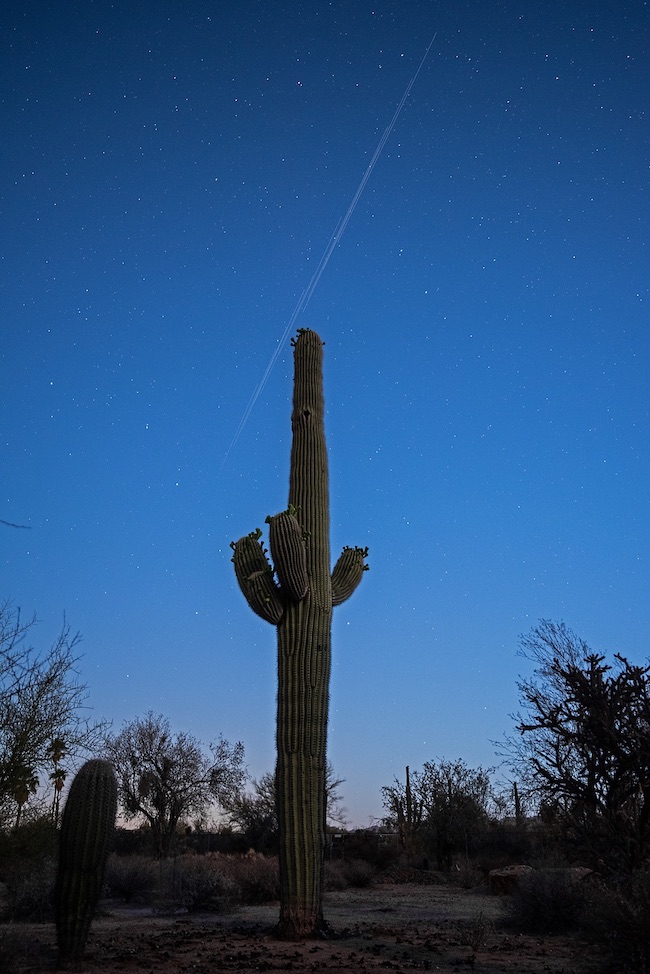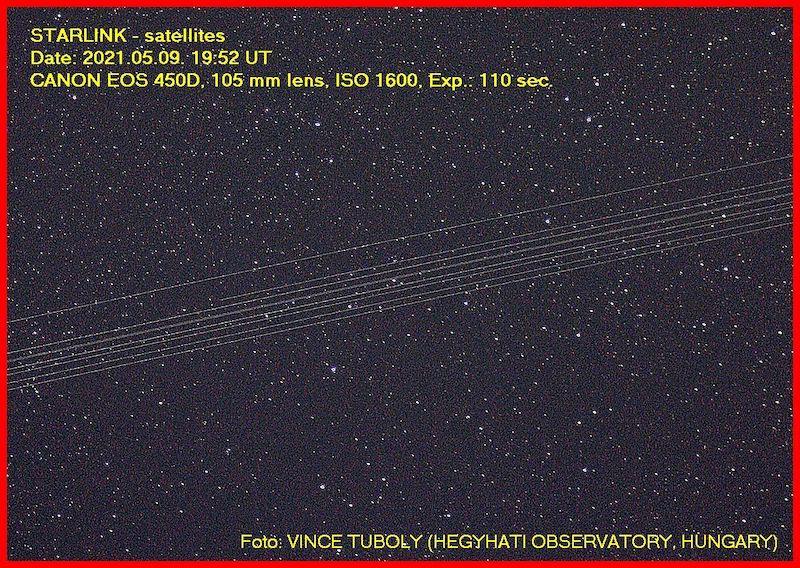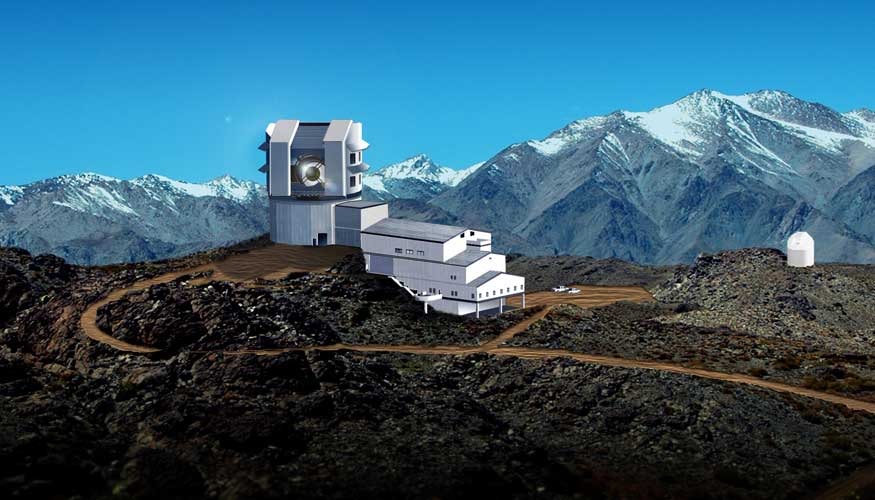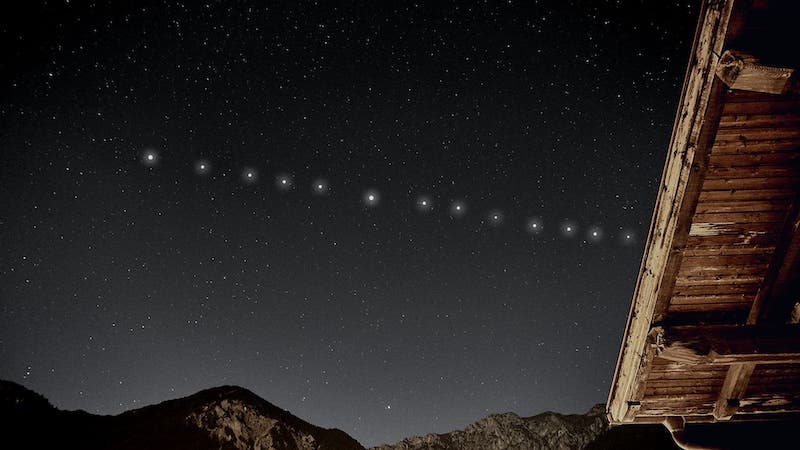
May 23, 2021
Lia De La Cruz

Here at EarthSky, we’re receiving many excited emails about sightings of lights traveling together across the night sky. UFOs? No. Usually, people are seeing Starlink satellites. Roger Oban in Tucson, Arizona, captured this photo of Starlinks on May 5, 2021. He wrote: “Shot in my backyard. I was just about to shut down, when 5 satellites came through, all in a straight line.” Thank you, Roger! Credit: Roger Oban.
Starlink is the name of a satellite network that SpaceX (US) is developing to provide global broadband coverage for high-speed internet access, particularly for people across the world in rural and remote areas. SpaceX has launched more than 600 new Starlinks this year, typically launching 60 at a time. As of last week, that places the number of Starlink satellites currently in orbit at more than 1,500. Over the coming few years, SpaceX plans to send up at least 12,000 Starlink satellites. Satellite internet is beamed through space at a rate that’s reportedly 47% faster than fiber-optic cable internet. All well and good. But the Starlinks are bright. They can be seen in the night sky. Each launch creates what’s being called megaconstellations – groups of satellites moving together. Is 2021’s sudden upsurge in the number of Starlink satellites also causing UFO sightings to increase? Plus, astronomers are worried. The Starlink satellites are photobombing astronomical images. They have the potential to interfere with the professional observations that have brought us our modern-day view of the cosmos.
The proposal for Starlink was announced by SpaceX CEO Elon Musk back in January 2015. Though it wasn’t given a name at the time, Musk said that the company had already filed documents with international regulators to place about 4,000 satellites in low-Earth orbit. He said in a speech when revealing the project:
“We’re really talking about something that is, in the long term, like rebuilding the internet in space.”
And his predictions so far have proven true. Musk’s initial estimate of the number of satellites quickly grew, as he hoped to capture a part of the estimated $1 trillion worldwide internet connectivity market. The U.S. Federal Communications Commission (FCC) has granted SpaceX permission to fly 12,000 satellites, and perhaps as many as 30,000 eventually. To put things into perspective: only about 2,000 operational satellites currently orbit Earth. Fewer than 9,000 have ever been launched in all of history, according to the United Nations Office for Outer Space Affairs. Starlink satellites orbit at an altitude of 340 miles (550 km). At that height, they’re low enough to get pulled down to Earth by atmospheric drag and burn up in a few years, so that they don’t become space junk once they die (a problem SpaceX may hope to tackle using Starship). Each one weighs 500 pounds (227 kg), and measures about the size of a typical coffee table, according to http://www.Skyandtelescope.com.
It was exciting to see the first few Starlink satellites, traveling together in the night sky. But then more were launched, and then more. And astronomers began to worry.

Credit: Vince Tuboly in Hegyhátsál, Hungary, caught these traveling Starlink satellites on May 9, 2021 and captioned it: New series Starlink satellites.
SpaceX’s two test satellites, TinTinA and TinTinB, launched in 2018. The mission went smoothly. Using that initial data, the company decided it wanted its fleet to operate lower than originally planned. Regulators deliberated and the FCC approved the move.
The first 60 Starlink satellites were successfully launched on May 23 2019 aboard a SpaceX Falcon 9 rocket. Members of the Starlink team plan to launch up to 60 more per Falcon 9 flight, with launches as often as every two weeks in 2021. Of the 15 Falcon 9 launches so far this year, all have been dedicated to lofting 60 Starlink satellites apart from two, bringing the total number launched so far this year to 722 as of today. One – the Transporter-1 rideshare mission in January – carried only 10 satellites, and the other – the Capella Space rideshare mission launched last Saturday – carried 52.
Starlink controversy within the astronomy community. Despite the promise of high-speed broadband internet, SpaceX has taken criticism within the astronomical community for its Starlink satellites, due to their brightness and potential to disrupt observations of the night sky. The National Science Foundation (US) and the American Astronomical Society (US) released a report on the situation in August 2020. Discussions among more than 250 experts at the virtual Satellite Constellations 1 (SATCON1) workshop expressed concern that the bright train of satellites marching across the sky will hinder their observations.
In response, SpaceX has begun outfitting their satellites with a blackened sunshade – called VisorSat – that the company hopes will reduce the satellite’s apparent brightness by reducing the amount of sunlight that’s reflected. This is just one of the six suggestions proposed by the SATCON1 team. Initial efforts at mitigating the spacecraft’s impact involved launching a prototype Starlink satellite later dubbed DarkSat earlier this year, which features a black antireflective coating. Recent ground-based observations of DarkSat in orbit found it half as bright as a standard Starlink satellite, which is a good improvement, according to experts, but still far from what astronomers say is needed. Jeremy Tregloan-Reed, a University of Antofagasta [Universidad de Antofagasta] (CL) astronomer on the observational team that assessed the prototype, commented:
“I would not consider DarkSat as a victory but instead a good step in the right direction.”
The team compared DarkSat with a typical Starlink sibling using a two-foot (0.6-m) telescope at the Ckoirama Observatory [Centro de Astronomía de la Universidad de Antofagasta] (CL)in Chile and found that although DarkSat’s antireflective coating rendered it invisible to the unaided eye it remains far too bright to avoid interfering with the Vera C. Rubin Observatory – now under construction in Chile – and other major telescopes.

Additionally, DarkSat’s darker color retains too much heat, so the company is sticking with the visor alternative instead.
Astronomers are hoping to observe VisorSat and compare it with DarkSat once observatories reopen following the Covid-19 shutdown. With SpaceX’s plans, plus Amazon’s Kuiper project, OneWeb, China’s Hongyan, and other projects launching their own global networks of hundreds or thousands of satellites with little to no regulation, the scale of astronomy’s satellite-constellation problem might only increase.

A trail of Starlink satellites characterized by their dotted appearance moves across a starry night sky. Image via Star Walk.
See the full article here .

five-ways-keep-your-child-safe-school-shootings
Please help promote STEM in your local schools.
Deborah Byrd created the EarthSky radio series in 1991 and founded EarthSky.orgin 1994. Today, she serves as Editor-in-Chief of this website. She has won a galaxy of awards from the broadcasting and science communities, including having an asteroid named 3505 Byrd in her honor. A science communicator and educator since 1976, Byrd believes in science as a force for good in the world and a vital tool for the 21st century. “Being an EarthSky editor is like hosting a big global party for cool nature-lovers,” she says.